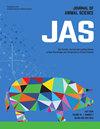Perinatal nutritional effects on postpubertal secretion of gonadotropins and feedback responsiveness to estradiol-17β in sexually mature heifers
IF 2.7
2区 农林科学
Q1 AGRICULTURE, DAIRY & ANIMAL SCIENCE
引用次数: 0
Abstract
Developmental changes in response to nutritional extremes may in some cases be manifested later in adult life. Objectives of experiments reported herein were to test the hypotheses that maternal nutrition during mid- to late-gestation interacts with postnatal nutrition during the juvenile period in heifers to impact 1) tonic secretion of gonadotropins, and 2) estradiol-17β (E2) negative and positive feedback responsiveness in adulthood. Heifers were selected from a larger population programmed nutritionally using a 3 × 2 factorial arrangement of pre- and postnatal diets. Beginning at 90 days of pregnancy, Bos indicus-influenced cows (n = 95) bearing heifer fetuses were fed to achieve body condition scores (BCS; 1-9 scale) of 3-3.5 (L; thin), 5.5-6 (M; moderate), or 7.5-8 (H; obese) by onset of the third trimester and maintained thereafter. Heifer offspring were weaned at 3-3.5 mo of age and assigned to either a low- (L; 0.5 kg/d) or high-gain (H; 1.0 kg/d) diet until 8 mo of age, then fed a common diet until puberty. Heifers (n = 18; 6/group) representing HH, MH, and LL combinations were ovariectomized postpubertally and received E2 replacement. In Exp. 1, blood samples were collected at 10-min intervals to evaluate pulsatile secretion of luteinizing hormone (LH) and follicle stimulating hormone (FSH) for 5.5 h. Heifers in the MH group (1.25 ± 0.11 ng/mL) tended (P < 0.09) to have greater amplitude of LH pulses compared to HH (0.91 ± 0.14 ng/mL) and LL groups (0.96 ± 0.09 ng/mL); otherwise, frequency, amplitude, and mean concentrations of LH and FSH did not differ among groups. In Exp. 2, heifers received E2 (2.4 ug/kg I.M.), with blood sampling at 30-min to 1-h intervals for 30 h. Exogenous E2 (Exp. 2) suppressed (P < 0.0001) mean plasma concentrations of LH and FSH equally among groups, then stimulated equivalent surges of LH beginning at 14 ± 0.4 h, with only two FSH surges detected. Similarly, neither negative nor positive feedback responsiveness to E2 differed among the treatment combinations studied..求助全文
约1分钟内获得全文
求助全文
来源期刊

Journal of animal science
农林科学-奶制品与动物科学
CiteScore
4.80
自引率
12.10%
发文量
1589
审稿时长
3 months
期刊介绍:
The Journal of Animal Science (JAS) is the premier journal for animal science and serves as the leading source of new knowledge and perspective in this area. JAS publishes more than 500 fully reviewed research articles, invited reviews, technical notes, and letters to the editor each year.
Articles published in JAS encompass a broad range of research topics in animal production and fundamental aspects of genetics, nutrition, physiology, and preparation and utilization of animal products. Articles typically report research with beef cattle, companion animals, goats, horses, pigs, and sheep; however, studies involving other farm animals, aquatic and wildlife species, and laboratory animal species that address fundamental questions related to livestock and companion animal biology will be considered for publication.
 求助内容:
求助内容: 应助结果提醒方式:
应助结果提醒方式:


